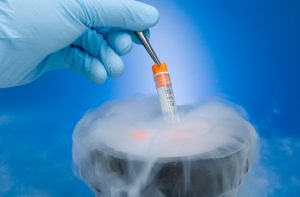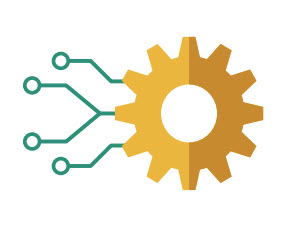Is Your Freezer Door Open? At Least You Didn't Have Thousands Of Embryos In There (Hopefully).
What are the 'damages' associated with losing the opportunity to have a child who's related to you?
 Two catastrophic and unrelated incidents regarding thousands of eggs and embryos happened this past week. First, University Hospitals in Cleveland announced that their warning system had detected that the temperature in a large liquid nitrogen-cooled tank had warmed beyond acceptable levels. At the time, the tank was being used to cryopreserve about 2,000 eggs and embryos, for about 700 families. I can only imagine the panic when the detection alert came though. The clinic attempted to move all of the eggs and embryos as fast as they could. They swiftly put them in different, appropriately cold storage tanks, and notified the affected families. Unfortunately, it remains unclear how extensive the damage to the genetic material is. Obviously, the fear is that all of the eggs and embryos are no longer viable.
Two catastrophic and unrelated incidents regarding thousands of eggs and embryos happened this past week. First, University Hospitals in Cleveland announced that their warning system had detected that the temperature in a large liquid nitrogen-cooled tank had warmed beyond acceptable levels. At the time, the tank was being used to cryopreserve about 2,000 eggs and embryos, for about 700 families. I can only imagine the panic when the detection alert came though. The clinic attempted to move all of the eggs and embryos as fast as they could. They swiftly put them in different, appropriately cold storage tanks, and notified the affected families. Unfortunately, it remains unclear how extensive the damage to the genetic material is. Obviously, the fear is that all of the eggs and embryos are no longer viable.
In a terrible coincidence, and just days after the Cleveland announcement, Pacific Fertility Clinic in San Francisco announced a similar catastrophic accident. They too had a liquid nitrogen-cooled tank malfunction. They determined that the tank was too low in coolant, which is, like, really important when trying to keep things cool with liquid nitrogen. Like the Cleveland clinic, the San Francisco clinic believes that thousands of eggs and embryos may have been affected. The clinic has contacted the 400 families with eggs or embryos to let them know about the terrible and unfortunate news. Imagine how devastating each of those calls must be.
The news of each incident broke on different days. But in fact, the incidents actually both occurred on the same date: March 4, 2018. There’s no evidence that the events are related at all, but wow, weird.

Attention Buyer: Not All Legal AI Models Are Created Equal
How Devastating Are We Talking About?
Dr. Carl Herbert, who works for the Pacific Fertility Clinic, gave a statement that expressed condolences, but explained that many of the eggs and embryos stored in the tank were 8-10 years old, and belonged to “people who probably won’t use them anyway.” The statement is either a little tone deaf, or very good news, depending on whether he’s talking about all of the genetic material, or just some of the people who it belongs to. If the eggs and embryos were generally “leftovers,” and just being preserved indefinitely, that’s certainly the best-case scenario for both the clinic and the patients. Of course, it’s unlikely that literally all of the genetic material falls into that category. For some, the eggs or embryos affected may have represented their only chance at having a genetically related child.
Lawsuits Galore.
You don’t even need to ask, yes, legal action is on the horizon. The first lawsuits have already been filed, with several more likely to follow. Lawyers for a couple with two embryos affected by the Cleveland thaw — Amber and Elliot Ash — filed suit on Sunday. They seek to represent a class of affected patients as plaintiffs against the Cleveland clinic. The Ashes report that the two embryos they had entrusted to University Hospitals held their only chance of having children after Elliot was diagnosed with cancer in 2014. The clinic told them that their embryos were no longer viable. So sad.
Sponsored

Attention Buyer: Not All Legal AI Models Are Created Equal

How To Maximize Productivity With Westlaw Precision With CoCounsel


The Ethical use of Generative AI


New Report - Are Small Firms Achieving Their Legal Tech Goals?
A second lawsuit was filed against the same Cleveland clinic by a Pennsylvania couple. This couple had struggled with infertility for eight years, and had been in the process of transferring their embryos to another clinic when the thawing incident happened. Talk about terrible luck.
What Kind of Liability Are We Talking About?
Among the problems with these incidents and lawsuits is that embryos remain in a legal gray zone as to what they are, and how they are “valued.” While Louisiana says by state law that human embryos are “juridical persons,” most jurisdictions don’t have personhood statutes. Instead, when faced with the question of whether eggs and embryos are life, most states deem them as property with special characteristics or quasi-property.
So if this had been Louisiana, we’d be talking about the considerations surrounding criminal manslaughter charges for the staff involved at the clinics. And even outside of the criminal context, at least one trial court in Illinois refused to dismiss a civil claim for “wrongful death” when a clinic accidentally destroyed a couple’s embryos. So for the clinics, the potential damages at issue are immense.
Even if the relevant courts don’t view embryos as persons, and more as the bodily “tissue” that the clinics have carefully referred to when describing the affected eggs and embryos, the damages could be extensive. The material was retrieved using IVF, and an individual IVF cycle can easily cost $10-20 thousand. Even to just cover the expenses for couples who could feasibly re-do the cycle at another clinic, that is some serious cash. And that’s the best case scenario; many families won’t be able to successfully repeat the IVF process now due to disease, age, or even the death of one of the genetic contributors. In the Ashes’ case, for instance, there’s no way to recreate the damaged embryos after Elliot’s cancer treatment. Theirs were irreplaceable and priceless.
Sponsored

New Report - Are Small Firms Achieving Their Legal Tech Goals?

Mitigating M&A Cyber Risk: Pre- & Post-Acquisition Due Diligence
Additionally, these cases present questions that are difficult for courts to answer. First, it’s impossible to know how many of the eggs or embryos would have actually been used by the individuals; as the San Francisco clinic noted, many families never intended to use this material. But surely they should at least be entitled to recoupment for their storage fees, and, given the incentives at play, might now claim that they had always intended to use the material.
Next, even for those who would have used the material, what are the “damages” associated with losing the opportunity to have a child who’s related to you? (Obviously, these families may still have the opportunity to adopt or possibly use donated eggs or embryos from others.) These are questions that courts — and perhaps our civil legal system more broadly — are not well suited to answer.
Clearly, the ramifications of these incidents are worth keeping a close eye on. Of course, clinics need to take protective measures to stop these situations from happening. And very large insurance policies may help compensate individuals in money and dollars when the freezers fail. But fertility treatment is one area that is uniquely laden with emotion, hopes, and sadly, when things go wrong, devastation. Of course, to those on the other side of the loss, no amount of money from a lawsuit can make them whole.
 Ellen Trachman is the Managing Attorney of Trachman Law Center, LLC, a Denver-based law firm specializing in assisted reproductive technology law, and co-host of the podcast I Want To Put A Baby In You. You can reach her at [email protected].
Ellen Trachman is the Managing Attorney of Trachman Law Center, LLC, a Denver-based law firm specializing in assisted reproductive technology law, and co-host of the podcast I Want To Put A Baby In You. You can reach her at [email protected].







